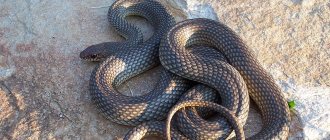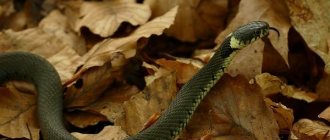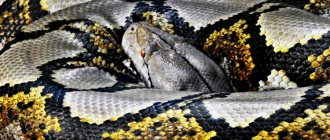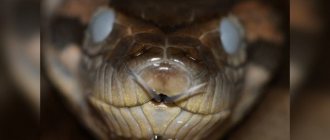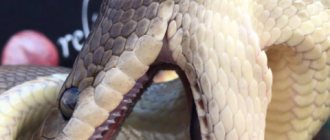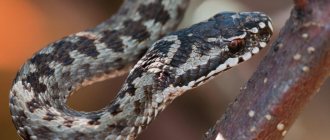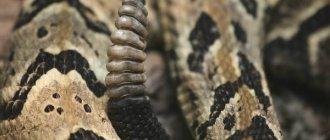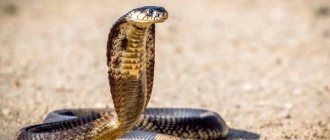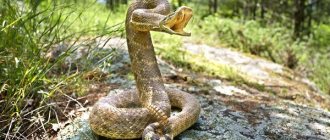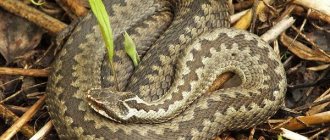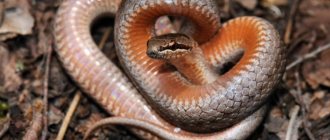In this article we will look at whether the copperhead is dangerous and its differences from other snakes.
Reptiles, especially snakes, that live near human habitation have always caused fear. And the copperhead has gathered around itself many dangerous stories and legends since ancient times. Moreover, the red-eyed snake or legless lizard was associated with evil spirits. This article will provide material on who such a reptile actually is. Should you be afraid of her and how to protect yourself from her attack if circumstances require it.
Common copperhead - snake or legless lizard: brief description
The common copperhead has a “sister” by name. In nature, there is another reptile with a similar root “name” - the copperhead or brittle spindle. Therefore, it is worthwhile to immediately understand this issue in order to dispel all the myths and rumors about such animals.
IMPORTANT: The copperhead is a snake! It belongs to the class Reptiles and the family Colubridae, and its species is non-venomous Snakes. But the copperhead is already a pseudo-legged lizard , which belongs to a completely different class - Reptiles, from the spindle family. Therefore, do not confuse these two different animals! And one should not call a snake and a lizard by the same name.
- The common copperhead is a small snake that is often mistaken for a viper. But they note its great strength and strength. The maximum length of the copperhead is 60-70 cm. Moreover, the body covers 4-6 times more length than the tail. More precisely, the copperhead is distinguished by its short tail.
- It is compared to a viper because the copperhead has smooth, dark-colored dorsal scales in the form of diamonds or hexagons. Which is very similar to the “zigzag” of a viper.
- Their color is also often almost identical. But there is a main difference between the copperhead and all other species, and for which it received its “name” - it is a copper tint. A special place is the belly and around the head. It is in this area that any color of the snake will shimmer with the color of copper.
- The color of the copperhead can be from a paradoxical gray color to a brown-brown-red color. Moreover, they can have a light tone of gray or such a rich shade that it looks like a black color.
- A distinctive feature of copperheads is that the female is always darker than the male. There is also a pattern when the snake becomes several tones darker during the molting period.
Snake
- Their abdomen can also be of different colors - from gray to red-brown, which often happens with a copper tint. But there are even representatives with a steel-colored belly.
- Copperheads can be completely monochromatic. Sometimes there are snakes with brown or black spots all over their bodies. There may be blurry spots or clear lines in the middle.
IMPORTANT: The iris of the copperhead’s eyes is yellow or red! It all depends on the species and habitat, but there are no other colors.
- Another small recommendation on how to determine the sex and age of a copperhead - look at the color intensity. If there are more red notes in its color, then this is a male, but a female has calmer brown tones.
- With age, the brightness of the color and clarity of the pattern is washed off and lost. Therefore, if you see a copperhead with a bright color, then it is young.
Origin of the species and description
Photo: Common copperhead
The common copperhead is a non-venomous snake belonging to the family of Colubridae and the genus of copperheads. This genus of snakes includes only three species of reptiles, including the common copperhead. Even in ancient times in Rus', legends and stories arose about this snake. The Russians believed that a copperhead bite would lead to death at sunset. This belief, like the name of the reptile itself, is associated with its color. On the belly of the snake, the scales are copper-colored, and this is especially noticeable in the rays of the sun. The eyes of the copperhead are also reddish.
Video: Common copperhead
The common copperhead is a small-sized snake, the length of its body does not exceed seventy centimeters. Males are smaller than females. The tail of copperheads is several times (4–6) shorter than the length of the entire body. The copperhead's head is oval, slightly flattened. Against the background of the whole body, it does not stand out much; there is no sharp transition from the body to the head. The surface of the reptile's skin is smooth and shiny. Apparently that’s why in the sun it shines even more with the color of copper ore.
Contrary to terrible legends and mystical beliefs, the copperhead is not at all dangerous to humans, because it does not possess poisonous weapons. She can, of course, bite, but it won’t cause much harm, other than a little discomfort at the puncture site. The copperhead often suffers because it is confused with a poisonous viper and attempts are made to kill it. To understand exactly what is in front of you, namely, a copperhead, you need to understand in detail its external features and find out the characteristic differences between this harmless reptile and a dangerous viper.
Common copperhead - poisonous or not?
We made a slight reservation on a similar topic when we recalled the appearance of the copperhead. But this question has a certain catch - it is a poisonous snake, but not for humans.
- The fact is that she has poisonous teeth. But they are located in the very depths of the mouth, especially since the size of the copperhead’s mouth is very small. Therefore, it will not harm a person. But, swallowing prey, it can easily kill it.
- It is also worth noting that it uses the secretions of the paracloacal glands to attack. They have an extremely unpleasant odor.
- To defend or attack, it often uses toxic saliva to paralyze. After all, its size is not so large as to strangle its victim. Therefore, before a meal, she paralyzes her.
Dangerous snake, but not for humans
- But we must not forget that she produces this toxin and the poison itself in small quantities. Therefore, the copperhead does not harm a large animal or, especially, a person.
- All rumors about its poisonousness are rooted in its resemblance to a viper.
- Also, people have long been frightened by her red eyes. There is even such a version: if bitten by a “copper snake,” the person will die before sunset.
- Many people attack the copperhead, mistaking it for a viper.
IMPORTANT: The copperhead is protected by law, since mass extermination has led to a decrease in the genus. This is a rare species! In some countries it is listed in the Red Book.
Population and species status
Photo: Common copperhead snake
Although the habitat of the common copperhead is quite extensive, the population of this reptile is small. Copperheads are rare because their distribution density is low. Herpetological scientists explain this by her food preferences. The copperhead's diet is based on lizards, and this type of food supply is not considered reliable compared to a variety of rodents and frogs. In those areas where the number of lizards is declining, the number of copperheads is also sharply decreasing.
People also influence the size of the copperhead population. They try to kill her when they meet, mistaking her for a dangerous viper. In addition, rapid human activity is leading to a reduction in the permanent habitat of this small reptile. Humans are gradually displacing the copperhead from its permanent place of residence, and this has an extremely negative impact on the copperhead population, because snakes lead a sedentary lifestyle and always try to remain in their territory, which they zealously defend.
As a result of this situation, the common copperhead is under protection in some states, where its destruction and illegal catching are strictly prohibited. In our country, it is listed in the regional Red Books of some regions and a number of republics.
How to distinguish a copperhead from a viper?
- Eyes are an important difference between these families. The viper has a vertical pupil, while the copperhead has a round pupil!
- Look at the shape of the viper's tail - it is short, thick and blunt. Colubrid reptiles have a narrower, relatively long and sharp tail. The tip of the viper itself is painted in a different color - yellow, orange or red.
- The viper's head is separated from the body and has a triangular shape, somewhat reminiscent of a spear. In the copperhead it acts as an extension of the body.
- While the color can be confusing, the scales are not. In a viper, each scale has a certain elevation in the center, which seems to divide it in half. That is, there is a cue . The copperhead doesn't have this!
- The viper also has a zigzag dark stripe , but it is not present in all species. Therefore, this is not the most reliable way to differentiate.
The main difference is the teeth
- The viper has poisonous front teeth . The copperhead does not have them. Her front teeth are not so developed, so they are not conspicuous.
IMPORTANT: Do not even think about touching a dead snake. Especially if there are signs of a viper lying there. Under no circumstances should her teeth be checked. This is not the most important sign to recognize the viper and copperhead. The danger lies in the fact that even a dead poisonous snake has venom on its teeth!
Protection from enemies
These animals are protected by a hidden lifestyle, as well as by bone chain mail located under the scales. In addition, they can throw off their tail and also “shoot” excrement. Unusual defensive behavior is observed in young individuals. In case of danger, young copperheads roll over onto their backs, showing their dark belly. Apparently, such a change in color produces the effect of surprise.
However, this arsenal is not enough, so the spindle often becomes a victim of various predators. Both ground beetles (predatory beetles), and various snakes, and toads eat young lizards. Martens, foxes, hedgehogs, badgers, night and day birds (there are more than 25 species of birds that feed on copperheads) - this is not a complete list of enemies of the species of interest to us. It is curious that among the snakes, the copperhead is especially often swallowed by the copperhead. People also destroy these lizards very often. In different countries there is a strange superstition about their “terrible poisonousness,” although in fact the spindles are absolutely harmless.
Copper snake - varieties: brief description, photo for children
Varieties of copperhead have not been fully studied. New subspecies are constantly being discovered. But science classifies them all as one species – the common copperhead. They are divided mainly by different colors.
Ordinary
Brown
In Russia, the gray or brown copperhead is more common. There are red or even pinkish copperheads. And in some areas there is even a black copperhead. But their most important feature is the copper tint of the back and abdomen.
Where does the copperhead live in Belarus, Russia, the Urals, Crimea, Tatarstan, how long does it live?
Such a snake lives about 10-15 years. Everything depends on living conditions. In captivity, they can live much longer, because the threat of attack by natural enemies disappears. They often become prey for wild boars, rats or martens, as well as some birds and hedgehogs. Juveniles may be attacked by grass frogs.
- The copperhead loves warmth, which is why it looks for sunny places. She can swim, but avoids swampy and damp places, as well as those near water bodies.
- It can be found in almost all deciduous forests. The secret is that she hides behind the leaves, but in meadows or steppes she can stumble upon her enemy. Therefore, the copperhead avoids them. You can also find the copperhead in the coniferous forest.
- This snake lives in both Belarus and Tatarstan, and also covers all European countries. In Russia, it reaches the border of Siberia and Lake Onega. In general, she chooses the southern side of European regions.
The copperhead loves warmth
- If we talk about the subalpine zone, the copperhead can rise 3000 meters above sea level.
- Their peak activity occurs in the morning and evening. Rarely occurs at night, but such cases have been reported.
- These snakes can attack their relatives. Therefore, only one snake coexists in one territory. Copperheads lead a solitary lifestyle. Such a “plot” of one snake does not exceed more than 1 hectare.
If you meet a snake
Not a single snake will pounce and bite a person first: these animals, if they are not chasing prey, are distinguished by a rather peaceful and calm disposition.
If a reptile attacks people, it is only for the purpose of self-defense. When meeting any snake, there is no need to grab it or try to chase it if the reptile itself is in a hurry to hide.
In order to avoid encounters with these reptiles, you need to try to walk in the places where they are supposed to live so that the sound of their steps can be clearly heard. In this case, you need to be especially careful and carefully look around so as not to accidentally step on the snake.
Tourists during hikes in the Urals may encounter a snake during a rest stop or on the route. In addition, reptiles sometimes crawl into tents and sleeping bags.
What to do in this case? Do not make noise or make sudden movements so as not to scare the snake. If you don’t harm her, she will try to crawl out of the tent as quickly as possible.
Return to content
What does a copperhead eat in nature: a description for children
It is worth noting that copperheads are very slow, so they attack resting prey or use ambushes. For these purposes, they are armed with grass or foliage.
- The basis of their diet is lizards. Often a battle can even break out between them. By the way, a copperhead can defeat a representative larger than its size. If the lizard grabs onto the snake very tenaciously, then the copperhead can tear it off along with its skin.
- They love lizards of all kinds - this is 60% of their diet. But more often they feast on spindles and nimble lizards.
- The copperhead has very well developed muscles. Stronger than that of a viper or snake. Therefore, she wraps the victim in several rings that can tenaciously hold even, for example, a small paw.
Copperheads feed on lizards
- The diet is also supplemented by rodents, especially voles and mice. Its menu also includes shrews, sparrows and some types of other snakes. She mainly chooses the cubs. This diet covers approximately 5% of the entire meal.
- The rest falls to the lot of insects and frogs (baby snakes especially feast on them).
- By the way, cases of cannibalism were also noted among copperheads. And the copperhead can often attack an entire nest of some animal and destroy all the offspring.
Snake activity season
In the Leningrad region, snakes wake up from hibernation in April, when the spring sun begins to actively warm up. The period from May to September is the warmest time of year in the region, and snakes are cold-blooded animals and therefore love to bask in the sun.
Peak activity is August and early September. This time also marks the peak of aggression from snakes.
Most often, the victims are mushroom pickers who accidentally step on the owner of the forest. Recently, information has often appeared in the media about increased activity of snakes in the Leningrad region.
Residents notice them in unusual surroundings - on city streets, in parks, squares.
How the respiratory system of the copperhead works: description
Despite this peculiar shape, the copperhead and other snakes have internal organs. But there is a certain feature that is common to the entire class.
- In the copperhead and other species, the left lung is reduced. This is due to the fact that the shape of the snake is narrow and oblong, and it has to crawl on the ground. To be able to wriggle without squeezing the organs, nature reduced one lung by almost 85%. It practically does not play any important role.
- But the right lung stretched to about a third of the length of the entire body. All responsibility for breathing rests with him.
- They also have a tracheal lung. It has a bag-like shape and is a continuation of the trachea. Its location is on the upper side of the posterior trachea. The tissue composition is reminiscent of a sponge, since it has many small cells in which gas exchange occurs.
IMPORTANT: The tracheal lung of snakes is used in situations, for example, when the right lung is compressed by a swallowed large animal. That is, its use is compensatory.
- Copperheads and other snakes have another unique feature - they can breathe while eating. They swallow their prey. Therefore, in order not to block the access of oxygen, this trachea is moved slightly to the side. And it allows you to breathe while eating.
- Just like other serpentine species, copperheads have an organ of charm that is their tongue. It is with its help that they catch odors.
Reproduction of brittle spindles
Little is known about the social and mating behavior of spindles, since all their contacts take place in shelters. During the mating season, males become aggressive and fierce fights occur between them. Their main weapons are teeth (since there are no limbs). Marriage partners find each other, apparently, by smell. They mate in the spring, with the male holding the female by the neck with his jaws.
The female bears the offspring for about three months. In mid-summer and early autumn, she gives birth to cubs in transparent egg shells. In nature, this happens somewhere in a secluded place. In a litter there are from 5 to 26 cubs, which immediately after birth begin to move, break the shells and crawl away. There have been cases of females eating newborns. Young spindles feed on small soil animals.
Not earlier than in the third year of life, having reached a length of about 25 centimeters, they become sexually mature.
How dangerous is the copperhead snake for humans?
In principle, the copperhead does not pose a serious danger to humans. It has already been mentioned that its poisonous teeth are located deep in its mouth. Therefore, for her to bite you, you will need to stick your finger deep into the throat. Similar cases have not yet been observed.
- But, like any reptile or even just a wild animal, it can cause infection. Especially if there was a bite to the point of bleeding. This happens, although relatively rarely. In situations where the place of attack was the hand or fingers.
- Do not forget that the copperhead does not clean its teeth, and can also feed on poisonous relatives. An infection from another animal or simply a piece of food that has already decomposed may remain on the teeth. In general, there is no talk of sterility. Therefore, the wound must be treated without fail.
- Persons with weak immune systems will be affected. After all, any infection can develop into a serious illness.
The snake does not pose a serious danger
- Allergy sufferers are also at risk! The reaction may not be limited to just a rash, itching or redness. Don't forget that allergies can affect the respiratory system. And the person will simply suffocate because the swollen throat will cut off oxygen.
- Small children can be bitten more easily and forcefully. And their curiosity often becomes the reason for this. Plus, young children do not have strong immunity to resist most dangerous diseases.
- Elderly people can also suffer from a copperhead bite. Any reptile attack affects heart function and blood pressure levels. Elderly people often experience differences in this area.
- The condition may worsen, as with any bite from a wild animal. The bite site will hurt and cause discomfort. But, if there are no allergies, infections and complications, then there is no danger.
Differences from snakes
When people encounter a legless lizard, they most often mistake it for a poisonous snake and try to kill the animal. Of course, reptiles have similarities: both legless lizards and snakes move by wriggling their bodies. However, if you look closely, you can find several pronounced differences between the two types of reptiles. Let's look at the difference using the example of two lizards: the spindle and the yellow-bellied lizard.
Firstly, they have movable eyelids, while in snakes they are fused, thereby forming a transparent protective layer over the eyes. Lizards have an ear opening, which is located behind the organs of vision. Snakes do not have it.
Secondly, the head and body are fastened differently in reptiles. If the spindle and the yellow-bellied do not have any narrowings in the neck area, then in snakes they are clearly pronounced.
What is the difference between a legless lizard and a snake? In lizards, the left and right parts of the jaws are connected more rigidly, in addition, these animals have a shoulder girdle.
TYPES OF SNAKES: CHARACTERISTICS AND STRUCTURE, LIFESTYLE
GYURZA SNAKE: TYPES, DESCRIPTION, PHOTO, NUTRITION, POISON, REPRODUCE, FEATURES
CAUCASIAN VIPER: DESCRIPTION AND PHOTO
CURRENT GECKO KEEPING AT HOME, PHOTO
Copperhead bite: symptoms in humans, first aid
Keep in mind that a copperhead can bite even an adult on the lower part of its leg. Therefore, try not to walk in open shoes where the copperhead may live. Let's look at its symptoms.
- If a copperhead has bitten, for example, your fingers or hand, then traces of two bites will be clearly visible (there are two of them). It will be difficult for her to bite through a larger area of the body.
- The bite site will be very painful, which is quite natural and normal.
- The affected area will swell and there will be slight redness around the bites. Again, this is the body's natural response to injury.
- Not always, but an increase in body temperature may occur. Also take into account your weight, because the toxic saliva of the copperhead acts depending on the volume of muscle mass.
The copperhead may bite
- Thirst and increased sweating are another symptom of a reptile bite.
- The pupils react poorly to light.
- A snake bite of any kind increases blood pressure and always increases heart rate.
- In severe situations, complications are observed: suffocation, swelling, severe deviation from normal heart function, and a strong surge in pressure is also possible.
IMPORTANT: The above symptoms are a normal reaction of the body. The copperhead is a wild animal, so its bite will cause discomfort to humans. All these symptoms will go away quickly if you take all the necessary measures, and you are not at risk. But, if inflammation or suppuration is observed around the wound, a strong rise in temperature, or any of the allergic and complicated reactions, then the victim must be immediately taken to a medical facility!
First aid for a copperhead bite
- The wound should be washed with running and clean water. As a last resort, you can at least use antiseptic wipes.
- Be sure to treat the wound with an alcohol-based antiseptic. This must be done within half an hour to prevent the spread of infection or the development of “bad” germs and bacteria.
- A cold compress should be applied to the bite site. You can simply use a bottle of cold water or a napkin soaked in cool liquid.
- Do not drink alcohol under any circumstances to neutralize the poison! This is a myth and just complete nonsense. Under the influence of alcohol, the blood thins, and the poison is only transferred faster.
copperhead
- If available, the patient should be given an anesthetic. Allergy sufferers should definitely take an antihistamine.
- The patient should take a horizontal position, relax and rest a little. You also need to provide the victim with plenty of warm fluids!
- If the condition worsens or if severe allergic reactions occur, the patient is taken to the hospital!
IMPORTANT: Cauterizing or cutting the bite site is strictly prohibited. All this will only lead to additional infection! It is useless to suck out the poison of the copperhead, since it simply will not be there.
How to keep and what to feed copperhead at home?
To keep such a snake at home, you need to create conditions as close as possible to natural conditions.
- The copperhead should live in a terrarium that is quite spacious. Be sure to take care of artificial lighting.
- Make sure that the temperature does not fall below 22 °C, and in cold weather does not fall below 15 °C.
- Pour earth and sand into her “house”, and lay foliage, branches and several pieces of tree bark on top.
- Don’t forget to monitor the humidity by periodically spraying your home with a spray bottle.
- We already talked about nutrition a little higher. Therefore, it is worth taking care of your supplies of lizards and snakes.
- By the way, the copperhead will hunt itself, but first you should feed it with tweezers. You can also give frozen product.
How high do copperheads jump?
Another myth that “walks” around the copperhead. They don't jump because they don't know how to do it! Their muscles are not so developed. Yes, she can do lunges, but nothing more. This is a natural defensive reaction. If you don’t disturb her or disturb her nest, then the copperhead will never attack first in her life.
When in danger, it usually moves to the side and curls up into a ball, hiding its head. It can hiss and lunge, but does not jump on a person. By the way, sharpness is her strong point.
Distribution zones
The copperhead is widespread in Europe, the Middle East and Western Siberia. But if we talk about Europe, then in many countries it simply does not exist: in Iceland, England, Ireland, Denmark and in large parts of Scandinavia.
Previously, the copperhead lived in Denmark, but was unable to adapt to the climatic conditions, which is why the entire population died out.
What are copperhead snakes afraid of: how to get rid of copperhead in your summer cottage?
The first rule for copperheads, as for other snakes, is noise. Therefore, install rustling film, bells or plastic bottles in your area. The main thing is that they are low near the ground. Then the snake will hear this noise. Also keep an eye on your territory. Remove any piles of leaves and debris. Then she will not have the opportunity to create her nest on your site.
A copperhead can crawl from the site into the house
- Also place sheep rope around the entire perimeter. You can even just use animal hair or old woolen threads.
- Copperheads don't like the smell of burnt rubber, so you can also get rid of old things. Saltpeter is another substance they don't like.
- The copperhead does not tolerate the smell of kerosene, but it can also become unpleasant for humans. Therefore, plant garlic on the territory or sprinkle mustard everywhere.
Feeding spindles
The brittle spindle is a predatory animal. Because of their slowness, they hunt mainly even more clumsy animals. The main food of spindles is insects, earthworms, slugs, insect larvae, and snails.
The vision of these lizards is extremely poorly developed. The main organ for orientation in space and searching for prey is the tongue. The copperhead first carefully examines the victim with a sensitive tongue, and then swallows it whole.
The lizard uses sharp teeth to hold prey. The brittle spindle gradually pulls the earthworm out of the ground entirely or unscrews the already pulled out part if it is not possible to pull out all the prey. Similarly, the spindle takes snails out of shells.
Common copperhead - reproduction, what does a baby copperhead look like?
Let us repeat that this is a viviparous snake, the young of which are born in an ovoid membrane. Their mating season begins in the spring, and their general activity lasts six months. During this time, she should leave offspring and quietly go to winter in September-October.
IMPORTANT: They have a certain unique ability - to store sperm in special seminal receptacles. If mating happened in the fall, then pregnancy will “wait” until spring.
- During mating, the male holds the female by the throat with his jaws, while wrapping himself around her body. After the “mating” process, the male leaves the expectant mother.
- The eggs are already born fully developed. Therefore, the cubs quickly break this shell.
- From 2 to 15 cubs can be born. These are full-fledged small snakes that are up to 17 cm long and have the same color, only with a brighter shade and pattern.
Young copperhead
- From birth they are independent and leave their mother's nest. They begin to hunt insects. Then they move on to small lizards, then to rodents.
- At three years old, they are ready for puberty.
Social structure and reproduction
Photo: Baby copperhead
As it has already turned out, copperheads prefer to live in complete solitude, avoiding collective existence, jealously guarding their land ownership. Reptiles become sexually mature at the age of three, and some individuals even later. The wedding season for copperheads begins with the arrival of spring, when they awaken from their winter torpor. Before the next winter hibernation, the snake needs to give birth to offspring.
Interesting fact: Mating in copperheads can also occur in the autumn, right before hibernation. In this case, the cubs are born only next summer, and the sperm remain in the female’s body until spring.
The partner remains with the female only for a short period of mating, then they part with her forever; he does not take any part in the fate of his cubs. During intercourse, the gentleman holds the partner by the neck area with his jaws, and he wraps himself around her body.
Copperhead cubs are born covered with egg membranes. The expectant mother carries the eggs in utero until the embryos in them are fully formed and developed. Usually, in one brood there are about fifteen small snakes. Almost immediately after birth, babies break through their membranes in which they are born. The length of small snakes does not exceed 17 cm, they are fully formed and independent.
The little ones immediately leave their mother’s nest and begin their isolated snake life, initially hunting for all kinds of insects and small lizards. In the wild, copperheads live from 10 to 15 years. The lifespan of reptiles living in a terrarium is much longer, because the conditions there are much more favorable and there are no threats from outside.
